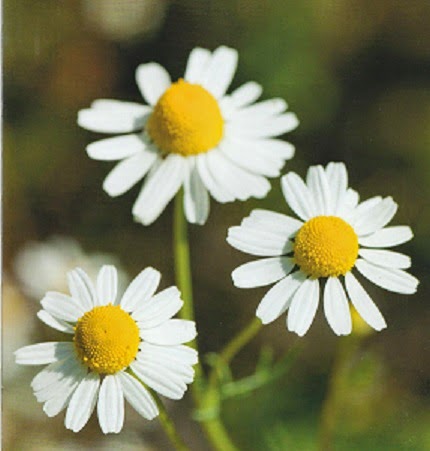Medicinal Plant: CHAMOMILE
Scientific or Botanical name: Matriarca recutita, Artemisa nobilis, Chamaemelum nobile
In Spanish Chamomile is called manzanilla which means "little apple" because the their distinct scent of apple. Chamomile is perhaps the most commonly used European herb in herbal medicine today. They are two species of chamomile well known German chamomile and English Chamomile.
Roman Chamomile is an erect, smooth-stemmed annual from 4 to 16 inches tall, and much branched above. The feathery leaves have narrow, divided segments. The flowers look like small daisies, about an inch or less across. found growing wild in dry conditions and also in gardens and cultivated areas in Europe, North America and Argentina. Roman chamomile has daisy-like white flowers and procumbent stems; the leaves are alternate, bipinnate, and final. German chamomile (Matricaria recutita) has similar effects to Roman or English Chamomile (Chamaemelum nobile) but a less pronounced aroma. When the chamomile flowers are dried it is easy to tell the difference between German and English chamomile by cutting a flower head in half-longitudinally. The receptacle the end of the stalk bearing
flowers, in German chamomile is hollow within; in English chamomile, it is
solid.
Both varieties of this herb have been prized for many centuries - especially brewed as a pleasant tasting tea- as a remedy for nervous tension, muscle cramps, skin conditions, and digestive upsets in babies, children, and adults. Commercial producers select these variations based on the specifications for a final product. Selection and breeding programs have resulted in producing higher quality chamomile with more stable, predictable components and higher levels of active ingredients. In addition to genetic differences, quality and quantity of essential oils depend on variables such as environmental factors, cultivation practices, plant parts and age, and post-harvest handling.
Parts used:
Flowers: single daisy-like flowers appear form early summer to autumn; double flowers are found in some varieties of roman chamomile.
Leaves: The fine aromatic feathery leaves gave rise to one of the plant's common names, "scented mayweed"
Main constituents:
Volatile oil (incl, proazulenes), flavonoids (incl. rutin), valerianic acid, coumarins, tannins, salicylates, cyanogenic glycosides.
actions: Anti-inflamatory, nervine, antispasmodic, bitter, sedative, tonic, anti-emetic, carminative, anti-allergenic
How to use:
Infusion
Pour 1 cup boiling water over 2 tsp of Chamomile´s flowers and leaves and take for mild digestive problems or insomnia, German chamomile is a gentle herb that is suitable for children at reduced doses.
Steam inhalation
Add 2 tsp of flowers of Chamomile or 5 drops of essential oil of Chamomile to a basin of boiling water for hay fever or mild asthma.
Tincture:
Take 2tsp (10ml) of the Chamomile's flower tincture 3 times daily for irritable bowel syndrome or nervous tension.
Bath:
Add 4-5 drops of essential oil of Chamomile to the bath to heal wounds or soothe the skin. Add 1 cup of strained infusion to a baby's bath at night to encourage sleep,
Cream/ointment/lotion
Use on insect bites, wounds, or eczema.
Caution:
Chamomile is very safe. In rare cases, allergic reactions occur, especially in those with severe ragweed allergies.
Can cause contact dermatitis.
Can cause contact dermatitis.
Avoid if you are allergic to the conpositae family.


